Send surveys embedded in your emails
Easily send surveys via email without the need for any third-party survey tools. Understand your customers and gain valuable insights to help improve your product and customer experience.
Tailor surveys with 7 question types
Craft your survey for maximum engagement by choosing from several templates including NPS score, multiple choice, open question, matrix style and more. Add up to 5 questions to your survey.
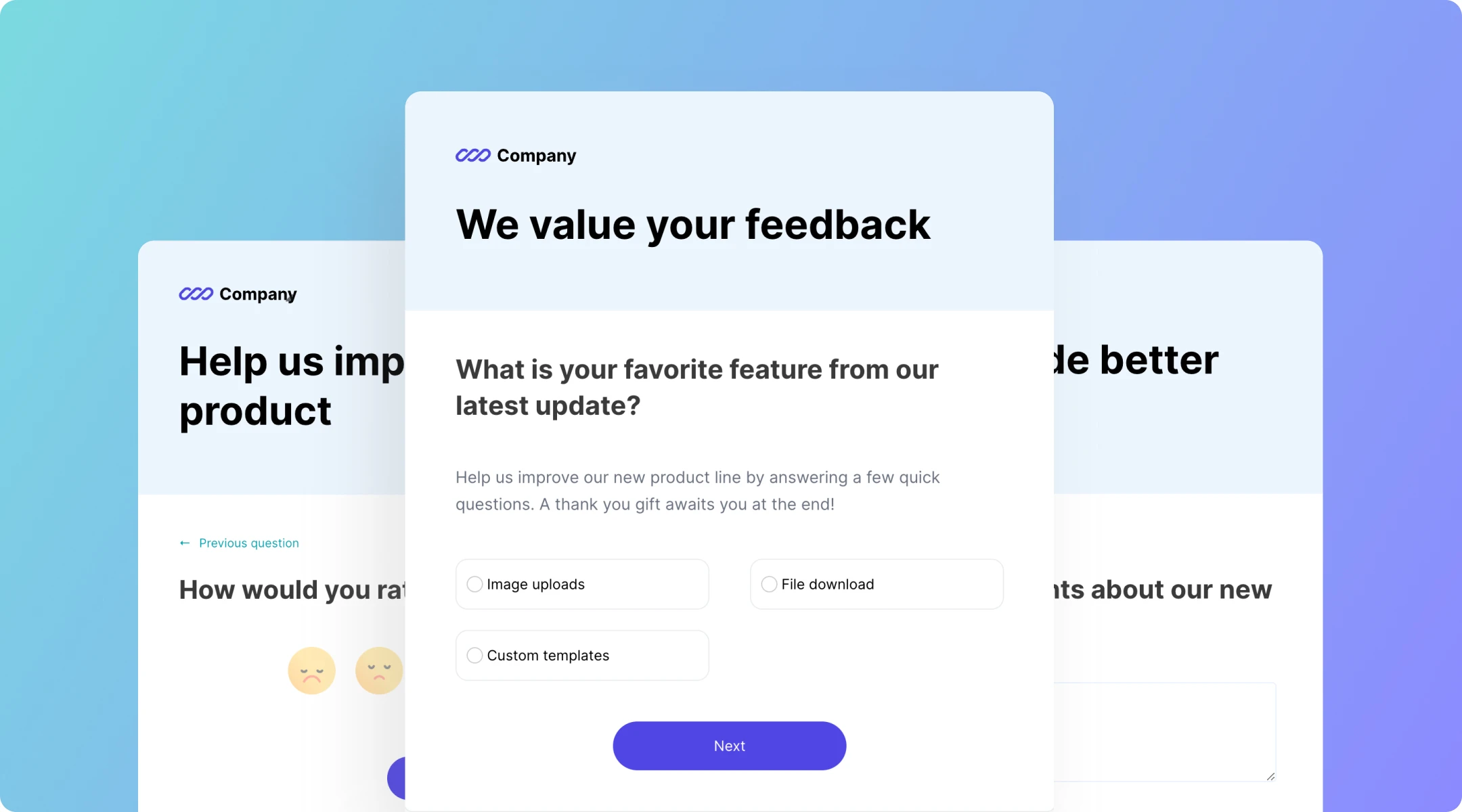
Why survey emails are great tools for businesses
More efficient than traditional data collection methods. Easily and quickly collect feedback from your customers.
Increase engagement—recipients are more likely to click when prompted by a survey.
Understand your users and customers in a more profound way and apply this to your business strategy.
Discover and resolve pain points with your product or service and increase customer satisfaction.
Use customer feedback to segment recipients and personalize further communication.
Build trust and strengthen relationships by showing customers that you value their opinion.
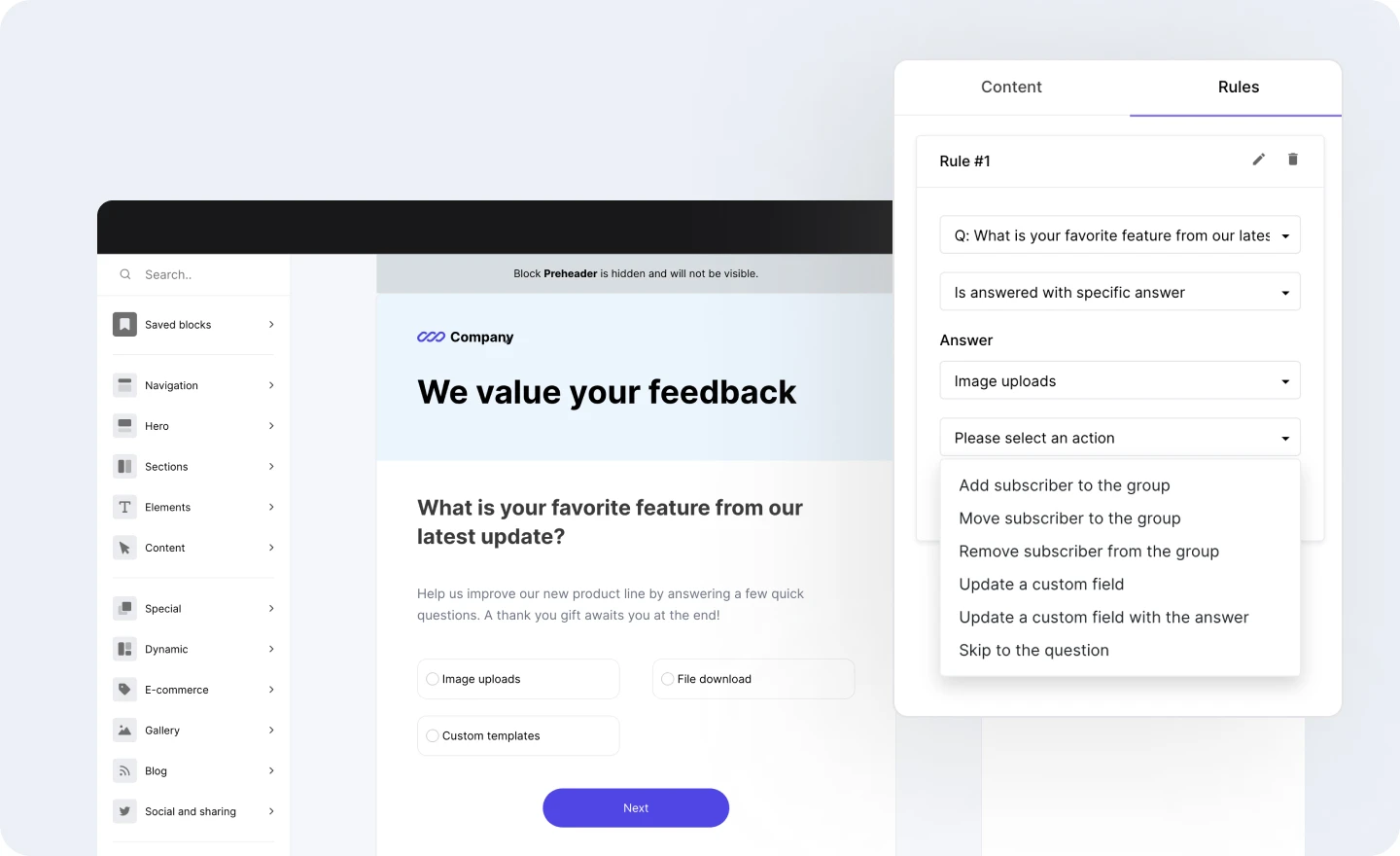
Use rules for a dynamic experience
Add survey rules for dynamic questionnaires that adapt based on the recipient’s answers. Skip questions and make the survey more relevant for the user.
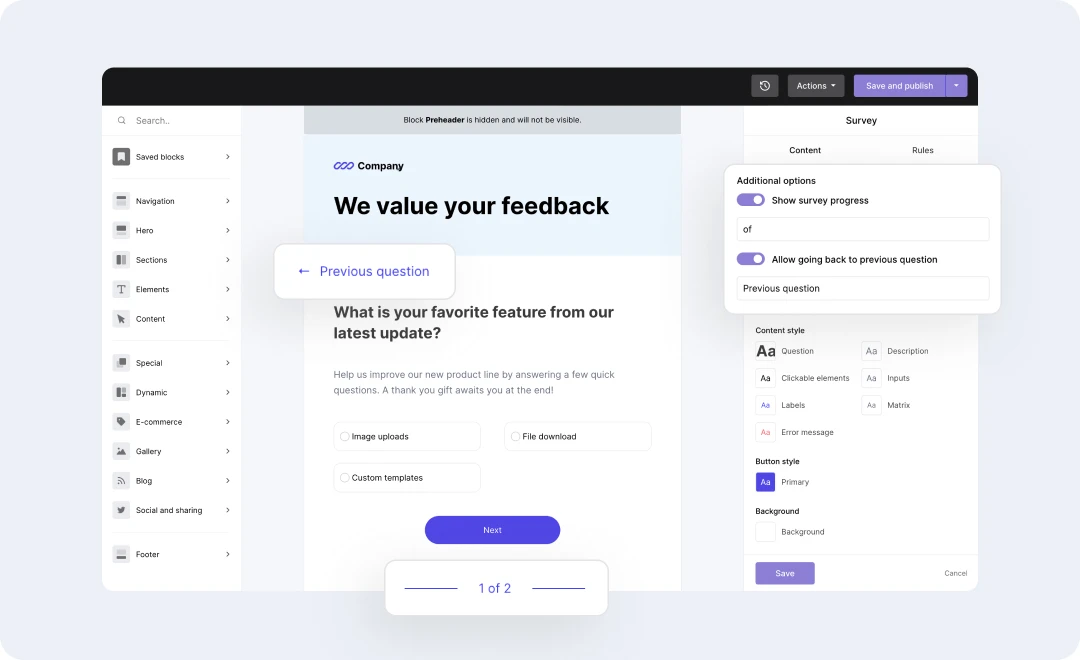
Maximize survey completions
Encourage respondents to finish surveys and maximize completions by showing their progress. Plus, allow people to adjust their answers by moving freely through the survey.
Integrations
User-friendly API with 7 SDKs
curl -X POST \
https://api.mailersend.com/v1/email \
-H 'Content-Type: application/json' \
-H 'X-Requested-With: XMLHttpRequest' \
-H 'Authorization: Bearer {place your token here without brackets}' \
-d '{
"from": {
"email": "your@email.com"
},
"to": [
{
"email": "your@client.com"
}
],
"subject": "Hello from MailerSend!",
"text": "Greetings from the team, you got this message through MailerSend.",
"html": "Greetings from the team, you got this message through MailerSend."
}'import { MailerSend, EmailParams, Sender, Recipient } from "mailersend";
const mailerSend = new MailerSend({
api_key: "key",
});
const sentFrom = new Sender("you@yourdomain.com", "Your name");
const recipients = [
new Recipient("your@client.com", "Your Client")
];
const emailParams = new EmailParams()
.setFrom(sentFrom)
.setTo(recipients)
.setReplyTo(sentFrom)
.setSubject("This is a Subject")
.setHtml("This is the HTML content")
.setText("This is the text content");
await mailerSend.email.send(emailParams);$mailersend = new MailerSend();
$recipients = [
new Recipient('your@client.com', 'Your Client'),
];
$emailParams = (new EmailParams())
->setFrom('your@email.com')
->setFromName('Your Name')
->setRecipients($recipients)
->setSubject('Subject')
->setHtml('Greetings from the team, you got this message through MailerSend.')
->setText('Greetings from the team, you got this message through MailerSend.');
$mailersend->email->send($emailParams);php artisan make:mail ExampleEmail
Mail::to('you@client.com')->send(new ExampleEmail());from mailersend import MailerSendClient, EmailBuilder
ms = MailerSendClient()
email = (EmailBuilder()
.from_email("sender@domain.com", "Your Name")
.to_many([{"email": "recipient@domain.com", "name": "Recipient"}])
.subject("Hello from MailerSend!")
.html("Hello World!
")
.text("Hello World!")
.build())
response = ms.emails.send(email)require "mailersend-ruby"
# Intialize the email class
ms_email = Mailersend::Email.new
# Add parameters
ms_email.add_recipients("email" => "your@client.com", "name" => "Your Client")
ms_email.add_recipients("email" => "your@client.com", "name" => "Your Client")
ms_email.add_from("email" => "your@domain.com", "name" => "Your Name")
ms_email.add_subject("Hello!")
ms_email.add_text("Greetings from the team, you got this message through MailerSend.")
ms_email.add_html("Greetings from the team, you got this message through MailerSend.")
# Send the email
ms_email.sendpackage main
import (
"context"
"os"
"fmt"
"time"
"github.com/mailersend/mailersend-go"
)
func main() {
// Create an instance of the mailersend client
ms := mailersend.NewMailersend(os.Getenv("MAILERSEND_API_KEY"))
ctx := context.Background()
ctx, cancel := context.WithTimeout(ctx, 5*time.Second)
defer cancel()
subject := "Subject"
text := "This is the text content"
html := "This is the HTML content
"
from := mailersend.From{
Name: "Your Name",
Email: "your@domain.com",
}
recipients := []mailersend.Recipient{
{
Name: "Your Client",
Email: "your@client.com",
},
}
// Send in 5 minute
sendAt := time.Now().Add(time.Minute * 5).Unix()
tags := []string{"foo", "bar"}
message := ms.Email.NewMessage()
message.SetFrom(from)
message.SetRecipients(recipients)
message.SetSubject(subject)
message.SetHTML(html)
message.SetText(text)
message.SetTags(tags)
message.SetSendAt(sendAt)
message.SetInReplyTo("client-id")
res, _ := ms.Email.Send(ctx, message)
fmt.Printf(res.Header.Get("X-Message-Id"))
}import com.mailersend.sdk.Email;
import com.mailersend.sdk.MailerSend;
import com.mailersend.sdk.MailerSendResponse;
import com.mailersend.sdk.exceptions.MailerSendException;
public void sendEmail() {
Email email = new Email();
email.setFrom("name", "your email");
email.addRecipient("name", "your@recipient.com");
// you can also add multiple recipients by calling addRecipient again
email.addRecipient("name 2", "your@recipient2.com");
// there's also a recipient object you can use
Recipient recipient = new Recipient("name", "your@recipient3.com");
email.AddRecipient(recipient);
email.setSubject("Email subject");
email.setPlain("This is the text content");
email.setHtml("This is the HTML content
");
MailerSend ms = new MailerSend();
ms.setToken("Your API token");
try {
MailerSendResponse response = ms.emails().send(email);
System.out.println(response.messageId);
} catch (MailerSendException e) {
e.printStackTrace();
}
}
Customize surveys with your branding
Easily edit the design settings of the survey block in the drag and drop builder so it seamlessly fits in with your brand colors and design.
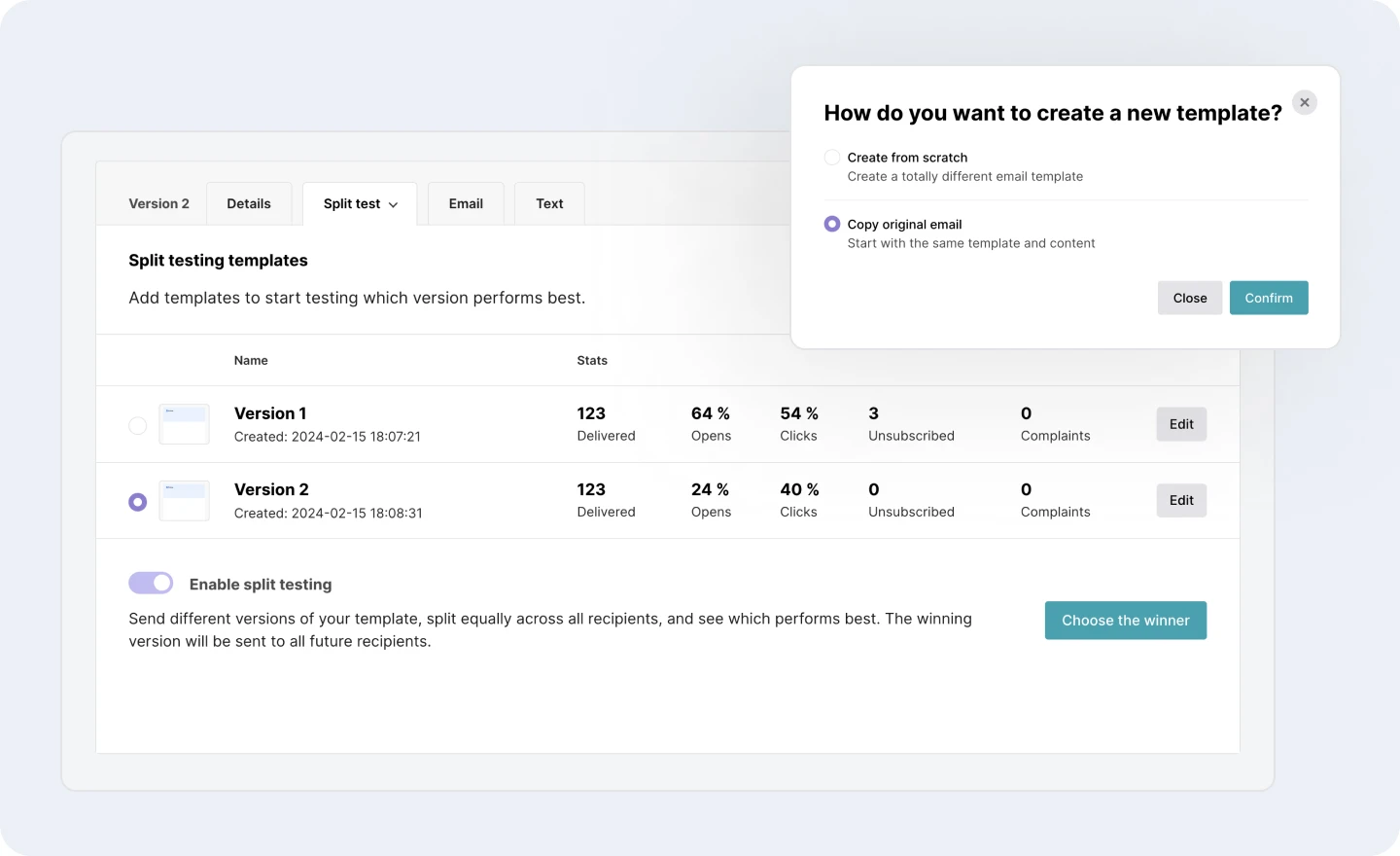
Split test survey email templates
Create multiple versions of your survey email templates to see which subject lines and email content perform best with split testing.
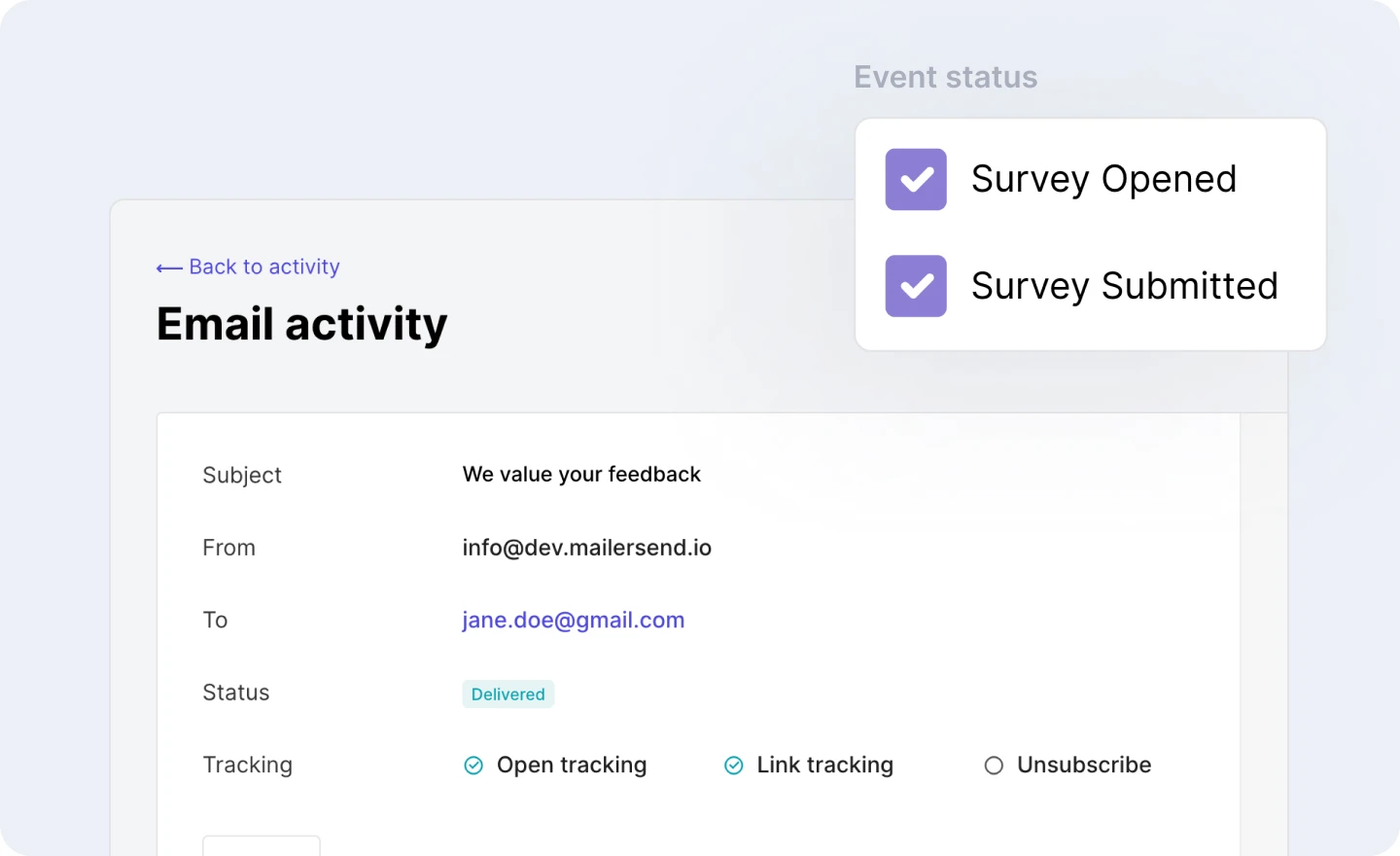
Track responses in real-time
Keep track of your survey progress in MailerSend’s Activity page. Filter email activity by survey opened and submitted to see how responsive your recipients are.
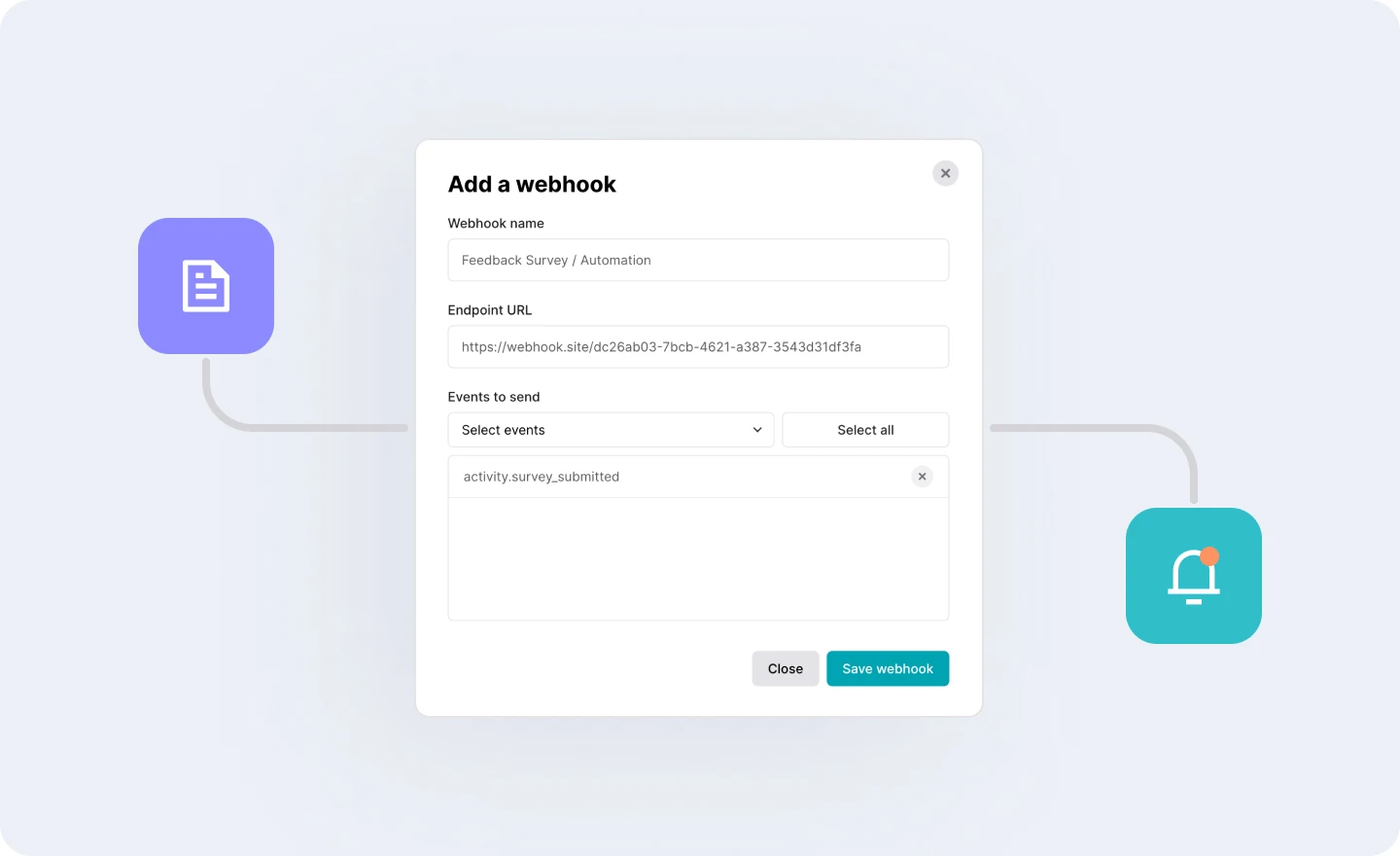
Enhance your surveys with webhooks
Get instant updates on survey feedback and activity. Use webhooks to collect survey data or trigger additional workflow automations based on recipients’ answers.
Use cases for surveys in your emails
-
NPS surveys
Learn what your customers think and how many detractors, passives and promoters you have with a Net Promoter Score. -
Market research
Gain valuable insights about your customers and use this data to drive your customer experience and product strategy. -
Customer satisfaction survey
Discover your CSAT (Customer Satisfaction) score to see how your business is doing and take steps to improve it. -
Customer support feedback
Allow customers to rate recent customer support experiences and identify areas of strength and weakness.
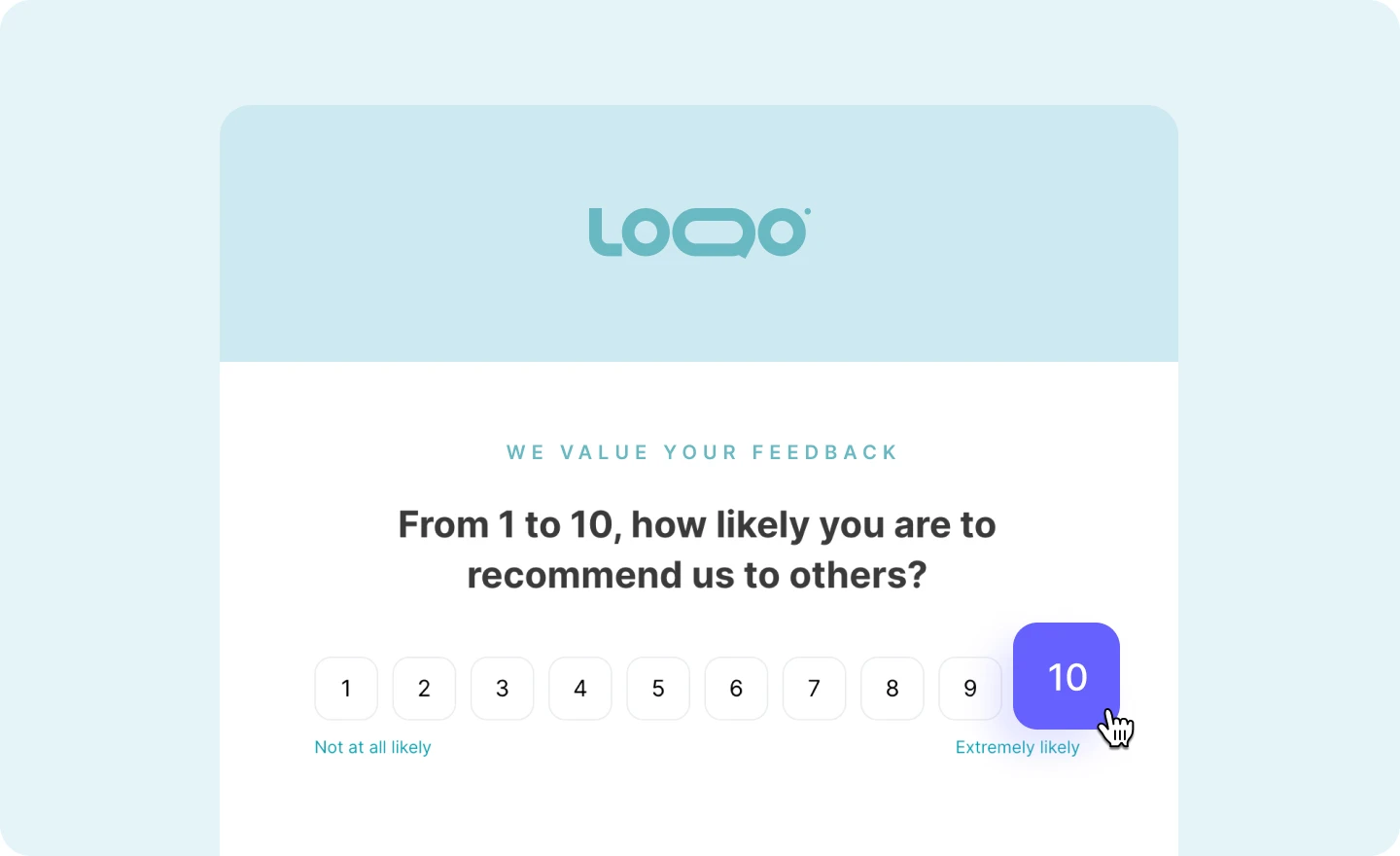
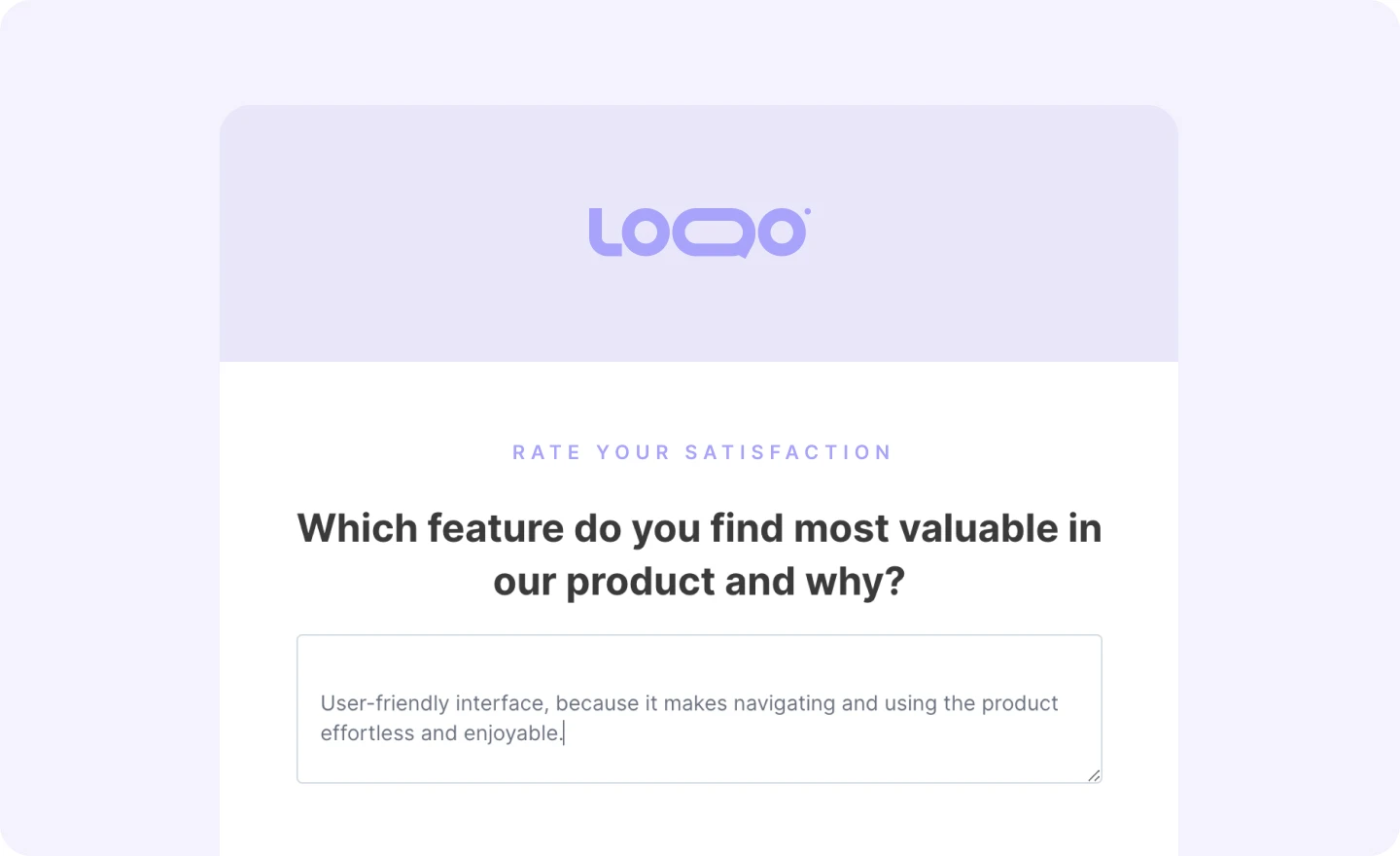
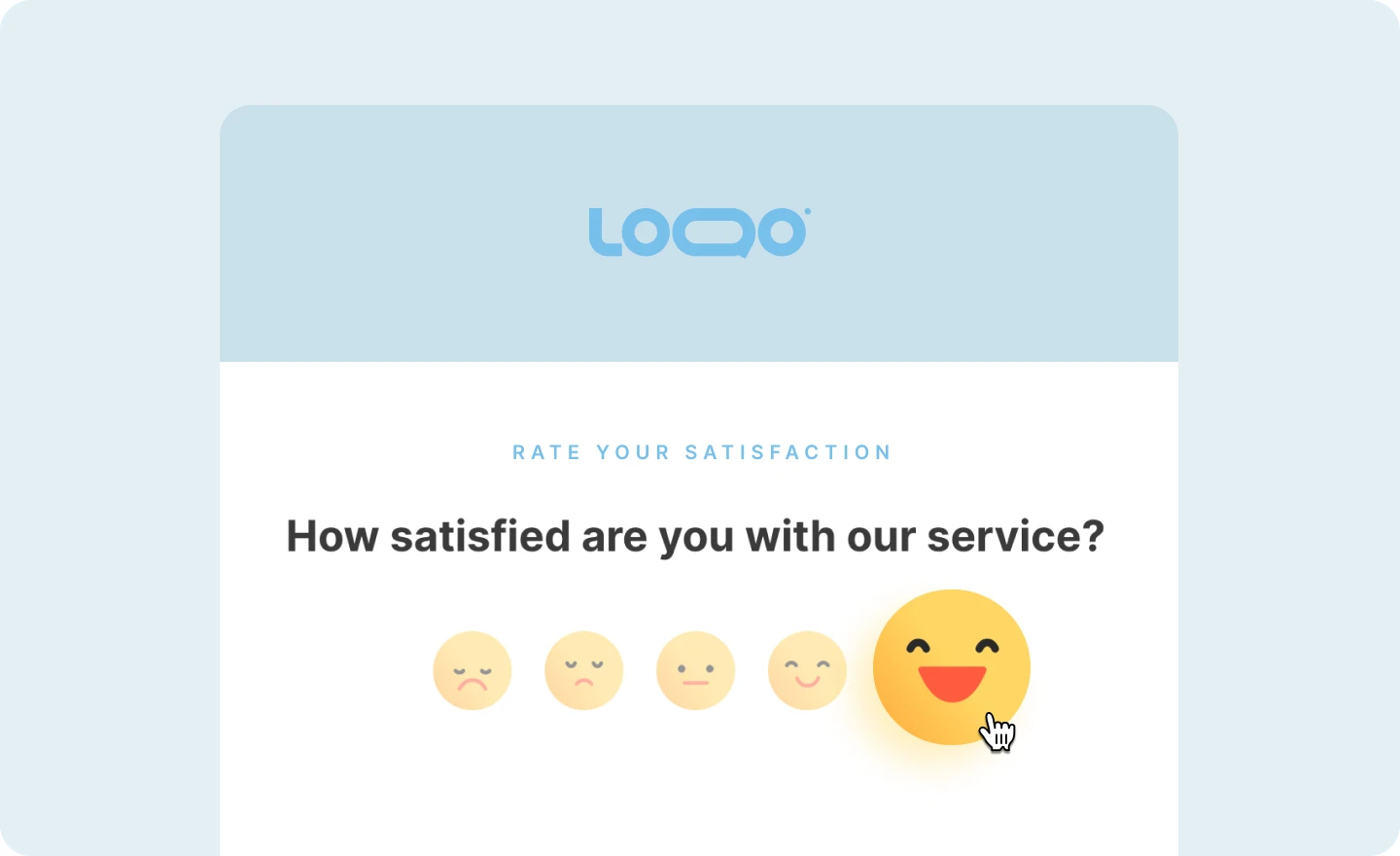
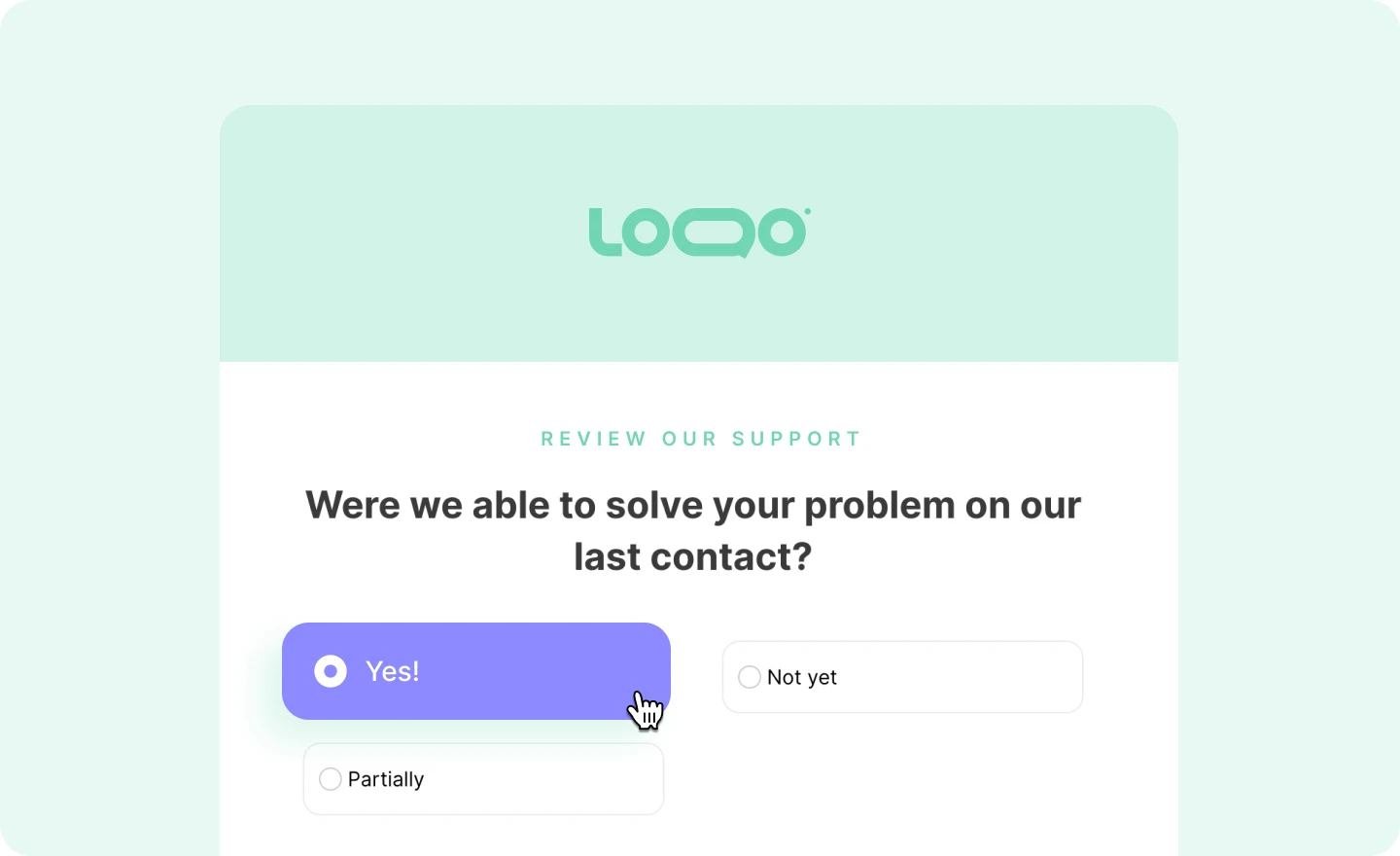
Learn more about your customers today!
Start sending surveys with MailerSend—learn how to create a survey email with our help guide.
Frequently asked questions
Are email surveys effective?
Surveys via email are one of the most effective ways to gather insights about your users and customer base. You can send surveys to your most valuable audience — your existing customers — meaning that their feedback will be more relevant. What’s more, surveys sent via email result in higher survey response rates than those sent by traditional methods, as they are easier for recipients to complete at their leisure.
Are survey emails subject to the CAN-SPAM Act?
According to the FTC, “Emails containing true opinion and research surveys may fall outside the scope of the Act, but to the extent that any such message seeks to advertise or promote a brand, a company, or a product or service to the recipient, it also may be primarily commercial in purpose, and therefore subject to the Act’s requirements and prohibitions.” You can learn more about how to send survey emails and best practices in our guide.
Do I need to enable any specific settings to use the survey block?
You must enable content tracking on your domain, and add the activity.survey_submitted and activity.survey_opened events to your webhook.
Are surveys considered transactional emails?
Yes, when you send a survey about a product or service, it is triggered by an action the recipient has taken and is therefore transactional. You can learn more about transactional emails in our guide.
How are survey responses collected?
To receive the answers from your survey, you‘ll need to use a webhook with the survey activities on the domain of the API token you’ll send it with.
You can view the results of a survey response by clicking on the event on the webhook page. For better readability of the results, you can parse the answers to your app or use an automation platform like Make or Zapier to send the webhook’s payload to any other 3rd party tool like Airtable or Google Sheets.
Can I integrate survey data with my CRM system?
Yep! You can use Zapier or Make to send the data to another app or create your own custom integration with the API to parse the answers to your CRM.
More features to explore
MailerSend is packed full of features that help you save time and grow your business.
Send emails
Email delivery
Enjoy the flexibility of sending a few emails or scaling quickly to send a few million.
Transactional emails
Intuitively-designed tools allow anyone to contribute, while an advanced infrastructure lets you scale fast.
SMTP relay
Use Simple Mail Transfer Protocol when you want to quickly send emails using a reliable Internet standard.
Email API
Start sending and tracking your emails with our easy API integration process and clean documentation.
Dynamic email templates
Build one-to-one customer relationships on a mass scale using a single email template.
Email verification
Verify a single email address or upload an entire email list to verify in bulk.
Email address validation API
Keep your recipient list clean and maintain great deliverability by automatically verifying incoming email addresses with the email address validation API.
API e-mails
Start sending and tracking your emails with our easy API integration process and clean documentation.
E-mail API
Zacznij wysyłać i śledzić swoje e-maile dzięki naszemu prostemu procesowi integracji API i przejrzystej dokumentacji.
Przekaźnika SMTP
Use Simple Mail Transfer Protocol when you want to quickly send emails using a reliable Internet standard.
Control your sendings
Webhooks
Get notified as email events happen so your integration can automatically trigger reactions.
Advanced email tracking
Every email is a learning experience. Monitor your email performance to find what works best.
Manage the unsubscribe page
Whether people are unsubscribing, give them a compelling reason to stay.
Email suppression list management
Protect your sending reputation by adding email addresses and domains that you should not send to.
Activity and performance logs
Easy access to detailed API and SMTP activity data and template error logs.
Track the results
Create emails
Custom HTML email builder
Interested in writing your own HTML code? Our HTML email template editor gives you the flexibility to build exactly what you want.
Drag & drop email template builder
Our drag & drop email editor empowers you to create professionally-designed transactional emails.
Rich-text email editor
Create plain text emails with the formatting capabilities of HTML. Add links, images, bullet points and style text with ease.
Email split testing
Email split testing will improve engagement with your transactional emails by helping you learn what your customers want more.
Control your account
User management
Invite your team members to collaborate on projects by assigning roles and granting permissions.
File manager
Streamline your workflow by organizing and keeping all your files in one place in the cloud.
Multiple domains
Use multiple domains to manage different brands or products with one MailerSend account.
Dedicated IP
Take control of your sending reputation with your own dedicated IP address and optimize your sendings for improved deliverability.
MailerSend iOS app
Access email activity, domain settings, and analytics on the go with MailerSend iOS app.






